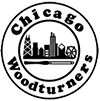Club History
Questions on formation of Chicago Woodturners
1. What motivated the founders to start a chapter? Initially, there was no organization available to give woodturners a chance to talk and discuss concepts. Two avid woodturners from the Chicago area, Tom Jesionowski and Dick Sing attended the Utah symposium which sparked interest. Subsequently, Dick Sing attended the first AAW symposium in Lexington Kentucky which fueled more interest in forming a chapter. Tom Jesionowski then took the lead, contacted the AAW, and requested a list of woodturners in the Chicago area. He then began contacting these individuals by phone to discuss the idea of forming a chapter. A number of people showed interest so there where two meetings at Tom’s home to formalize the chapters organization. During the second meeting, officers were created and Tom was elected as the first president. The original name of the chapter was Northern Illinois Woodturners. In 1991 the members decided to change the name to Chicago Woodturners to more accurately reflect the area that the club services.
2. How many joined the new chapter?
Six individuals met to form the chapter. In addition to Tom, they included Dick Sing, Bill Hochmuth, Jack Turley, John Cascarano, and Lee Rouch but in the first year the group had grown to about 13. The club has continued to grow to its current size of approximately 175.
3. Where did the first group meet?
After the two initial organizational meetings at Tom’s home, the first official meeting was held at Dick Sing’s home. Meetings then rotated to various members homes for a period of time. After more members joined, meeting moved to the conference room at the company of one of the members, followed by an area high school, then the basement of a local Woodcraft store where the club met for about 15 years.
4. How much were the dues?
Originally there were no dues, just a group of woodturning enthusiasts getting together to share their passion. A few years later, dues were established at $25/year. 29 years later, the dues have not changed.
5. Are there any original members still involved with the chapter?
Three members from the 1980’s are still involved with the organization; Dick Sing, Bill Hochmuth, and Bob Bergstrom.
6. What are some of the favorite memories of the chapter?
The original meetings were very informal but a lot of fun and very educational. Whoever hosted the month’s meeting held it in their shop. The host for the month was also responsible to put on the demonstration. The host normally had a cooler with drinks along with deserts or other snacks. It was a great opportunity to see other turner’s shops, equipment, tools, and projects.
In early years, members had to re-arrange their shop to make room for seating. A positive of hosting a meeting was that you had to clean your shop whereby finding all the tools you thought you had lost.
In the early years, the members were from all over the Chicagoland area. That meant that some months you had to drive for over an hour thru rush hour traffic to get to a members home for a few hour meeting. We were so addicted and hungry for information that we didn’t care how long it took.
Over the years the body of work changed significantly. It started with all bowls with small feet and an occasional platter; pieces with cracks, bark inclusions, wormy wood or mixed media were verboten. After a few years you began to see natural edge bowls and hollow forms. Coloring and texturing came much later.
7. What are some of the milestones of the chapter?
1987 – Chapter formed
1991 – Changed chapter name from Northern Illinois Woodturners to Chicago Woodturners
1995 – The chapter began seeking out world renowned turners to visit and demo in Chicago. Initially it was up to 3 per year. Today it has increased to 4-5 per year.
2008 – Held its first regional symposium (Turn-On! Chicago)
2009 – Became a 501 (c)3 organization
8. How has the AAW affiliation affected the chapter?
Initially the AAW simply provided the mechanism for woodturners to get together and share ideas. In later years, it also began providing guidance for best practices on topics such as safety, teaching methods, techniques, and organizational structure.
